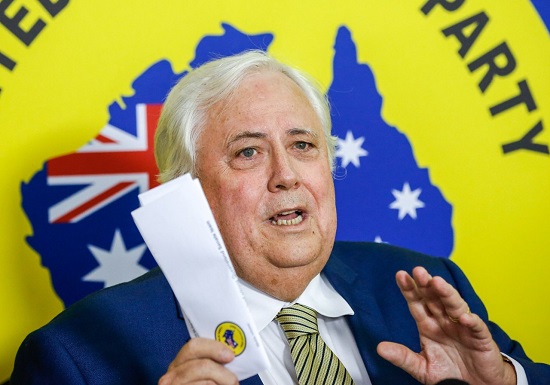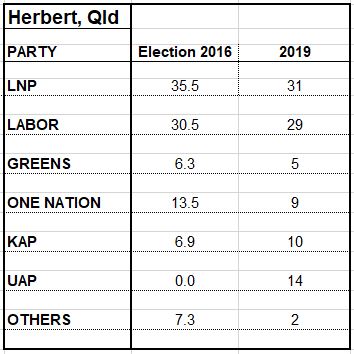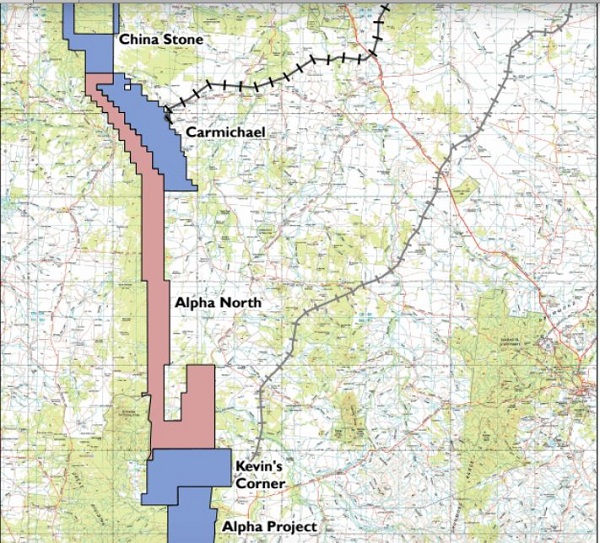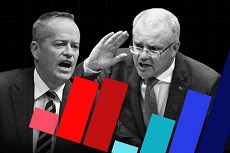Clive Palmer wants balance of power in the senate. Why? He wants a future for coal mining, and the development of his Galilee Basin tenement. Simple as that.
So I’ll take a look at Palmer’s impact on the campaign and how the senate is likely to turn out.

Mike Seccombe in The Saturday Paper has the background story in What Clive Palmer wants for his $60m.
Palmer is not a novice in politics. During the 1980s he worked for Joh Bjelke-Petersen and, according to Wikipedia, served:
- as the National Party’s campaign director during the 1983 state election and as media spokesman during its 1986 election campaign, both of which were successful.
- Later, having made his fortune in real estate and mining, Palmer became one of the biggest donors to the conservative cause in his home state. But the long, cosy relationship busted up spectacularly in 2012, in a dispute with the Liberal National Party government of Campbell Newman over access to the vast coal reserves of the Galilee.
Palmer had a plan to build a railway line from his tenement to the coast, but the Newman government gave preference to Adani and GVK further north.
As you would recall, Palmer then started his own party, won the seat of Fairfax and had three senators elected.
Palmer is not a fool and knows that he will not get any lower house seats this time. Newspoll of 26-28 April found the Coalition at 38 (down 1), Labor on 37 (down 1), the Greens on 9 (steady), One nation on 4 (steady) and UAP on 5 (up 2).
So Palmer’s UAP and One Nation now split the ‘up yours’ vote, but Palmer has taken one point off each of the majors. TPP was 51-49 in favour of Labor, closing from 52-49.
This was highly encouraging for the LNP, but Kevin Bonham explains that the actual result was 51.6 to Labor, but was taken down to 51.4 by taking into account the effect the UAP-LNP preference deal would have on Palmer’s preference flow. In 2016 the LNP garnered 53.6% of Palmer preferences. Galaxy/Newspoll have now made that 60%, which made the differnce in Labor being rounded to 51 instead of 52 in the TPP vote. (I think William Bowe at Poll Bludger may have been the first to notice.)
Some have pointed out that in 2016 Palmer preferenced Labor last in every electorate. However, in It’s not what you ask, it’s how you ask it Peter Brent says that the overt reciprocal effect of the agreement with the LNP could have a broad effect. It seems that nearly half the ‘up yours’ votes to ON and UAP come from Labor, and the preferences don’t always flow back to Labor. Brent says the decision by Newspoll to calculate the preference flow from UAP to the LNP from 53.4 to 60 has shifted the dynamics of the campaign, the question is by how much.
I think it’s clear that the election will be decided in about 40 seats, plus a few independents and a couple of possible Green gains. Indi and Wentworth are likely to return to the LNP, Zahli Steggall has some chance in Warringah, Bob Katter, Andrew Wilkie and Adam Bandt will roll on, and Rebekha Sharkie is favoured to hold Mayo.
On The Greens, the likeliest pick-up is probably Macnamara, based on the old Melbourne Ports, where Labor’s retiring Michael Danby was almost beaten by Steph Hodgins-May in 2016. His margin of 477 votes has narrowed to 76 under the new boundaries.
If you are interested, check out the seat and scroll down to the candidates on Antony Green’s ABC guide. Hodgins-May is an environmental lawyer and social justice advocate, with excellent credentials ranging from the UN to a small business owner. Labor’s Josh Burns is grandson of Jewish migrants, which helps in the area, but substantive experience seems to be as a political staffer, first with Danby, then with Premier Daniel Andrews. My money would be on Hodgins-May.
The thing about small parties in that they are strong in a relatively small number of seats, where their vote can be multiples higher than the national poll. One such is Herbert, based on Townsville. Here’s a single seat poll published in The Australian on 23 April 2019:

You’ve got no idea how long it took me to make that!
The poll has a 4.3% either way accuracy, but chances are it’s somewhere near right. Remarkably, it shows that Cathy O’Toole won the seat by 37 votes from a primary vote of only 30.5, finally through a leakage of preferences from One Nation.
Palmer’s vote seems to have taken from everyone except the Katters, to become the leading protest party in a city where he has majorly and serially pissed off everyone with the closure of the nickel plant and 850 out of work.
Best of luck predicting the outcome this time. O’Toole is a gutsy fighter and has openly and steadfastly supported Adani in the town where most of the Adani jobs are and will be.
On the same day in April, the Oz published single seat polls also for Deakin, Vic, Pearce, WA, and Lindsay. In summary there were swings to Labor in Deakin (about 9%) and Pearce (1.7% but LNP lost 4) and a slight swing the LNP in Lindsay, but no change in TPP. Across those three seats, on average, the major party vote was strong (combined 80.2 and now 80.4) whereas in Herbert it dipped below 60. Palmer in those three seats averaged 6.7 to One Nation’s 2. The Greens dipped from 8.6 to 6.7.
A mesage to take from the above is that in each of the seats there will be a very particular contest, depending on local circumstances. I’ve noticed that in individual seats LNP members are spruiking the specifics of what they have done in the area. For example, the candidate in my seat of Ryan highlighted fixing local traffic congestion, which is especially crook around Indooroopilly, Chapel Hill and Kenmore. I can’t see that anything substantive has been done, and it’s really a local government and state responsibility.
Now we need to consider that the preference deal with Palmer will be a negative in many seats, especially, I think, in Victoria, but also in in the Greater Brisbane area, where the LNP have about 6 marginal seats to defend, but it’s hard to estimate the extent.
So I’m thinking that across most of the country Palmer will have the effect of helping Labor a bit, but in seats where his vote is strong it could help the LNP, and in complex seats like Herbert, where the party vote is split every which way, could make the difference for the LNP.
The Senate
In large part Palmer’s push in the House of Representatives is very expensive advertising for his push in the senate.
Tim Colebatch has a useful article Voters are back in charge in the senate
Unlike in 2016 when the quota was 7.7 per cent, it is now 14.3, so minor parties will find the going tougher. Under the current senate voting rules it is reckoned that candidates will need about 8 per cent primary vote to make it on preferences. Palmer could well get that much in Qld.
Colebatch says that the vote for the senate in each state will split 3 left (where Green and ALP live) and 3 right (LNP plus ON, UAP, and ‘independents’ like Derryn Hinch.) To get a fourth you need at least 57.1 per cent of the vote, which is rare, although the last Victorian election translated nationally would just about have done it for Labor.
I’ve been through Antony Green’s Senate Preview and make the continuing senators 16 LNP, 13 Labor, 3 Green, 2 Centre Alliance (in SA), and one Australian Conservative (Cory Bernardi) to make 35. So 41 to be elected.
Going through Colebatch’s forecasts, the basic pattern is 3 LNP, 2 Labor and 1 Green in NSW and Victoria (sorry Mr Hinch, thanks for your services, happy retirement!), 2 LNP, 2 Labor and 1 Green in Qld, WA and Tasmania. The territories will split 1 each LNP and Labor, which leaves SA, which he says is too hard to call.
In SA Colebatch is guessing 2 each to Labor and LNP, pointing out that SA is the weakest state for The Greens. I’m backing Sarah Hanson-Young in. Whatever would we do without her?
Adding all that up, and remembering that 38 is the magic number for a senate majority, I have 32 LNP, 27 Labor, 9 Greens in the major parties, the 1 one Nation (Pauline Hanson) plus 2 CA and 1 AC in SA. That makes 72, with only 4 in doubt. They are the 6th seats in Qld, SA, WA and Tasmania.
There is no upside in any of those for Labor or the Greens, so write them as needing 2 more when voting together.
The LNP could possibly jag a third in Qld, Tasmania and WA, which would leave them with 35 and still 3 short. So now lets look at the possibilities.
In Qld the sixth seat will be between Malcolm Roberts for One Nation (Steve Dickson was only ever second on the ticket), Clive Palmer and the third LNP, a bloke called Gerard Rennick. Rennick is notable for claiming that the Weather Bureau is fudging temperature data to perpetuate global warming hysteria, and believes early childhood education is a conspiracy to further government control over their minds.
Of course, people could always vote for Fraser Anning.
One Nation’s day is done, one sole angry and bitter lady, with her life experience etched on her face. So the smart money is on Clive Palmer, thanks to the preference swap and the fact that the senate paper from left to right will read Rise up Australia, One Nation, United Australia Party, and then the LNP, with The Greens in 8th and Labor in 10th spot. (In every state the LNP has scored on the draw, and Labor bombed.)
So count Palmer in.
In Tasmania Colebatch says Labor 2, Greens 1, Liberals 2, last seat hard to call, possibly Liberal. So we’ll go with LNP. That leaves Jacqui Lambie out.
In WA Colebatch says Labor 2, Greens 1, Liberals 2, last seat hard to call, possibly Liberal. So we’ll count one more for the LNP.
SA is a mess, but it’s hard to see the LNP getting a third.
That would leave the LNP on 35, needing 4 more from a crossbench of 5 after electing a speaker. The crossbench would be Pauline Hansen, Cory Bernardi and the two from Centre Alliance (Stirling Griff and Rex Patrick) plus an unknown to be thrown up in SA, but probably conservative leaning. That could be Centre Alliance, it could be Palmer’s UAP, or…
The limit of Palmer’s possibilities lies in jagging a senator in SA and/or WA. Possible, but very unlikely. If Palmer is by himself he is by nature not collaborative, so in the run of things would have less impact on legislative outcomes than say Derryn Hinch did.
For Labor, however, they will have to get very lucky to get a co-operative crossbench, unless Lambie prevails and strange things happen in SA, or Victoria goes for Labor in a landslide. Centre Alliance have stopping franking credits as a cornerstone of their campaign. I’m not sure how they stack up on other matters, which is important, because franking credits is not a game-changer in a Labor budget in the first term, amounting to $10.7 billion over the four-year budget period when expenditure will be north of $2 trillion.
The monster mine
Clive Palmer really wants to develop his monster coal mine next to Adani. Here is Palmer’s Alpha North tenement in relation to Adani’s Carmichael:

Back in June 2014 in the post The game is up I reported David Spratt’s assessment from the science then available that there was no longer any burnable fossil fuel budget compatible with acceptable chances of achieving a safe climate, or, if you like, avoiding an unacceptable chance of Armageddon.
We should have stopped burning fossil fuels as soon as we possibly could, even if it meant economic pain.
Ian Dunlop has given eloquent and logically compelling reasons why we should stop now.
Clive Palmer during the 2013 – 16 term actually stopped Abbott the wrecker from eliminating the CEFC, ARENA and the Climate Change Authority. He knows better, but that does not constrain his greed.
In other news Clive Palmer’s $100m Aboriginal foundation only has $109 in it, records show:
- Clive Palmer’s $100m foundation to benefit Aboriginal people launched 10 years ago only has $109 in it, despite never having disbursed a grant or allocation, according to financial records published by the Australian charity commission.
The Western Australian government said it intends to investigate the situation.
“We are currently investigating any avenues which might be available to compel Mr Palmer to make good on his promise,” WA’s Aboriginal affairs minister, Ben Wyatt, told Guardian Australia.
“Any candidates standing for Mr Palmer’s reheated political party should explain how they themselves reconcile standing for a party whose central figure has behaved in such a disgraceful and untrustworthy manner towards Aboriginal people.
Indeed.
I’m hoping that the young come out strongly and clear this mess away!
However, every senate voter in Qld should vote below the line to make sure who they want most and least out of Malcolm Roberts, Clive Palmer and Gerard Rennick. Putting Roberts last is a no-brainer. Choosing between an ineffective and thoroughly unsuitable senator who wants to but probably won’t get to mine some coal, and yet another climate denying, planet wrecking LNP senator is not at all straight forward.


Ms Steggall running against Tony Abbott in Waringah?
A
Pedants Anon
Yet back in June 2014, Clive Palmer was at a press conference with Al Gore when he said this:
SBS News headlined Anti-Adani convoy rides into ‘hornet’s nest’ in coal-rich Queensland town, dated Apr 27, says:
Clive’s apparent promotion for more coal from Australia is an odd way for Australia “to do its fair share” for contributing to solving the global problem of climate change, wouldn’t you think?
Posted at the SMH, dated 2 Jul 2014, Al Gore told to avoid Clive Palmer’s environment circus. I think Al Gore should have heeded the advice.
This is a handy place to see how Politicians voted.
https://theyvoteforyou.org.au/
We normally know how the Majors and greens vote but the Indies are a bit on the low down.
If it is hung then knowing their record is very important.
Considering how Hince voted I don’t see why Colebatch has him on the right.
And I don’t know If SA Centre Alliance number 1 Senate pick Skye Kakoschke- Moore is up for re election ( never heard her to be honest) be the way she votes don’t put Centre Alliance on the right either.
And don’t both looking at Clive Palmers record, he was never there.
I personally have told those that have asked about Clive that he’ll be waaaay down the ballot on my paper.
But I think he has quite a few fooled.
Ambi, thanks. Don’t grow old. Now I think a word and something different sometimes comes out.
Warringah!
Jumpy, a bloke who only shows up 30% of the time might do less harm than a climate denier.
Ambigulous (Re: MAY 7, 2019 AT 1:39 PM)
Indeed, she is, and apparently quite strongly if you believe the polls. Well shall see in about ten days’ time.
Headline in The Age online.
“Palmer’s Party ‘undecided’ on immunisation…”
Weep, Louis Pasteur, Howard Florey, and a million health professionals.
Herd immunity, Mr Palmer: public safety.
You can’t “make Australia great” if the kiddies and adults are going to contract communicable diseases in large numbers.
Get vaccinated, Clive.
John Oliver had a tasty piece on Palmer as an entree to his story on lethal injections. Very appropriate, since if this self serving loon gets the balance of power Australia is rooted.
A small point, it’s Warringah, not Waringah.
On Immunisation, there was a fascinating conversation with Richard Fidler on How a milkmaid with cowpox changed history.
Posted late yesterday at the SMH is an article by Nick Toscano, Cole Latimer and Anthony Colangelo headlined ‘Legally forseeable’: Regulators warn companies on climate change risks. It begins with:
Will Clive Palmer ignore these warnings?
A few days ago Greenpeace released a report titled Dirty Power: Big Coal’s Network of Influence Over the Coalition Government, by investigative journalist Michael West & analyst Simone Marsh. The Executive Summary begins with:
I recommend you read it before you vote.
Posted late yesterday at the SMH is an article by Nicole Hasham & Cole Latimer headlined Experts cast doubt on Coalition’s power price pledge. It begins with:
There’s more eloquence earlier this week from Ian Dunlop in his op-ed headlined Modelling Climate Change Minutiae. It concludes with:
GM, that’s a seriously good article by Ian Dunlop. It should be sent to every political candidate, and every member of the MSM should learn it by heart.
Bria Fisher has form in working on behalf of the mineral industry and using bogus assumptions. It is meant to produce big scary numbers, but Peter Martin pointed out that the numbers were quite small. The $200+ to $500+ billion he says Labor’s climate policy will cost the economy actually means that by 2030 the total output of the economy between now and then will be less by something between those two amounts. As Quiggin says it means total output will be a couple of months behind where it would have been.
That’s on the assumption that his assumptions are correct, which they are not. The biggest error is that doing nothing will cost nothing.
Brian (Re: MAY 11, 2019 AT 12:47 PM)
Indeed it is. So is the Dirty Power report – IMO it explains much why the COALition are behaving the way they are.
And yet the argument that a transition to 100% renewables will cost us more (or can’t be done) is a lie, as the April 2019 report Global Energy System Based on 100% Renewables. Power, Heat, Transport and Desalination Sectors, by LUT University (Lappeenranta) and Energy Watch Group (Berlin) suggests. The key finding is (on page I, bold text my emphasis):
ABC Q&A has advertised who’s on the panel tonight:
Simon Birmingham, Liberal campaign spokesman;
Tanya Plibersek, Deputy Opposition Leader;
Richard Di Natale, Leader of The Australian Greens; and
Helen Haines, Independent candidate standing for Indi 2019.
Will a question on climate change (and renewable energy transition) emerge? What will the panel members say?
GM, climate change is bound to be a topic. We are going for pizza with our son and I hope to be back in time to watch it.
In news just in:
Mr Morrison is not running for Pope.
He said so himself.
David Pope has confirmed the story.
“He can’t run and he can’t hide”, Mr Pope gloated.
Here endeth the Epistle.
Peace be Upon You All.
St. A
Patron Saint of Patrons
The Buck Stops Here
In earlier news, the ALP candidate for Dawson had a loon try to ( and thankfully fail ) blow up her car.
We’ve had quite a few southern loons up here lately and Belinda Hassan has refused on multiple occasions to answer if she’s for or against Adani.
As has our own highly esteemed Jumpy.
And in other news from the Loon Pond, a Greens candidate near Parkes has stepped aside because he seems to have doubted that the murderer convicted of the Port Arthur slaughter, did it.
Not likely to help the Greens Senator for Tasmania, Sen McKim.
At AmbiBet, we are now opening a book on how many more candidates will topple by singular misadventure, self-inflicted, before Election Day.
Someone has to make money out of these clowns, don’t you agree?